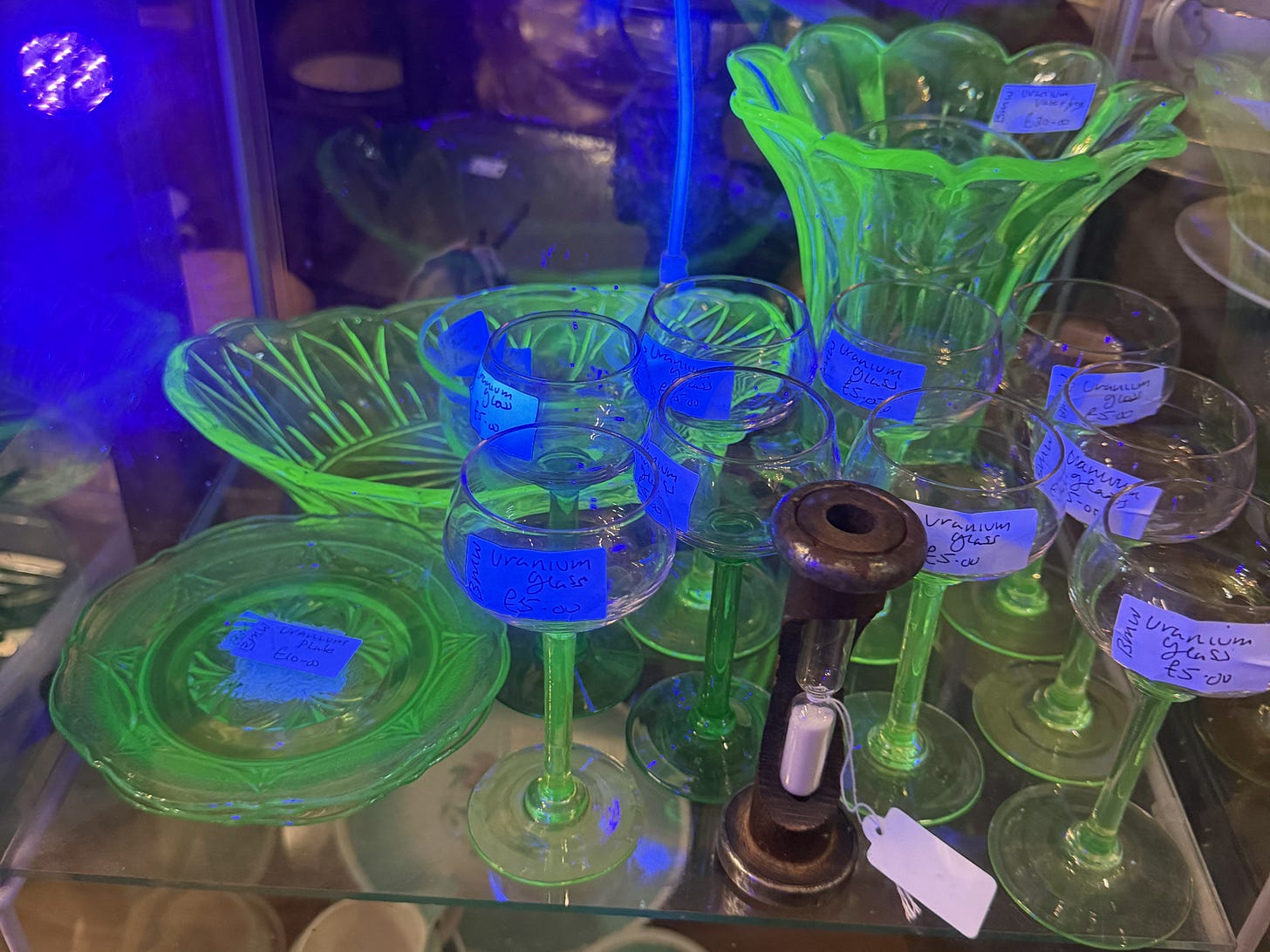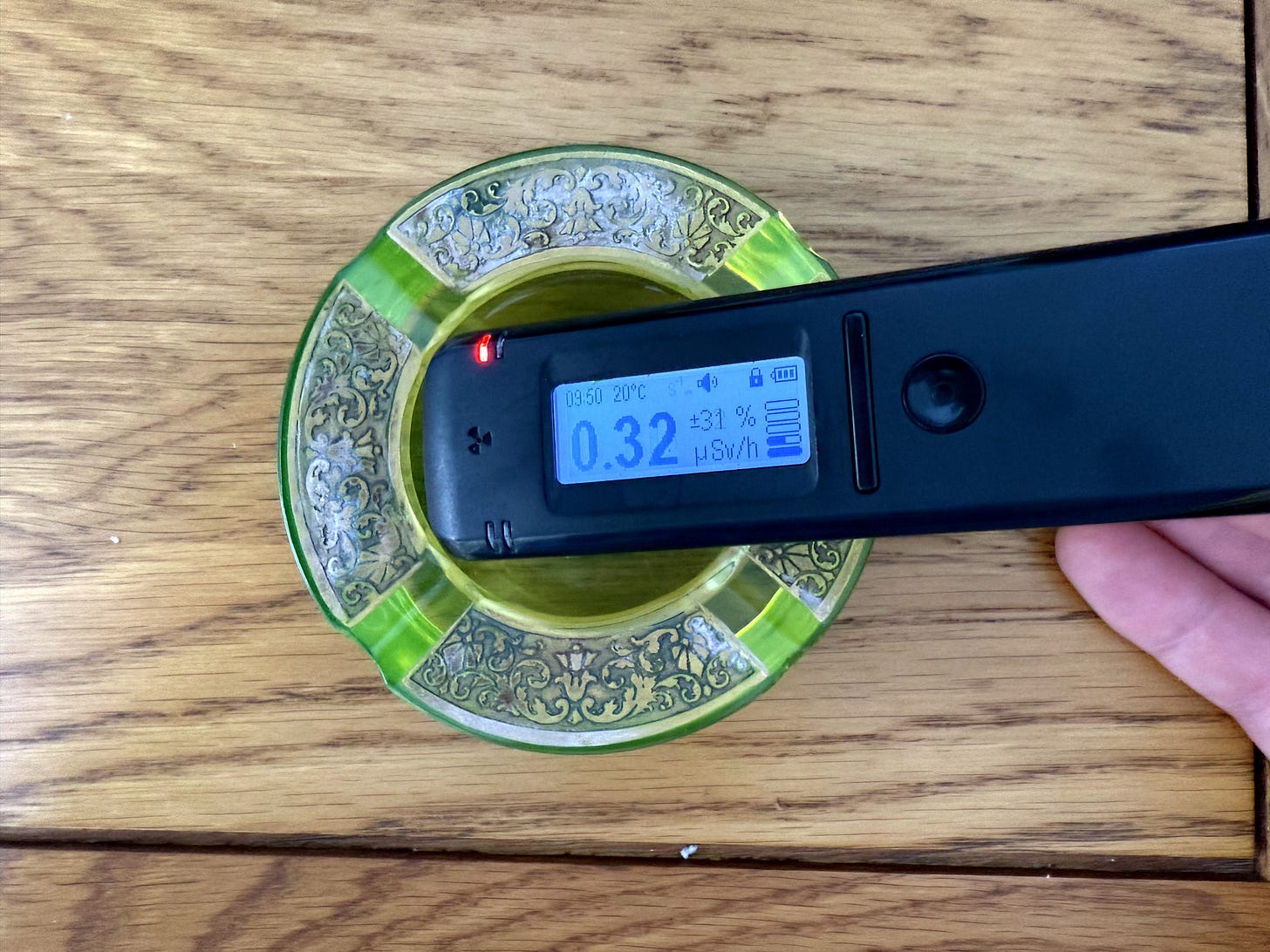What is Uranium Glass?
For the uninitiated, the world of uranium glass can be a little daunting. Is it dangerous? Why does it glow? I’ve written this article for newcomers of uranium glass hunting to act as your guide.
If you’ve found your way here, you’ve likely seen it. That ghostly, electric-green shimmer sitting quietly on a dusty shelf in an antique shop lit up by UV lights. Or maybe you’ve seen a video of someone waving a UV torch over a cabinet, revealing a hidden world of ghostly Halloween glow.
It’s why I started Radium Quest, as the thrill of the hunt tends to begin with uranium glass, and then opens up to a vast world of other radioactive antiquities. But for the uninitiated, the world of uranium glass can be a little daunting. Is it dangerous? Why does it glow? And most importantly, how do I find more of it?
I’ve written this article for newcomers to uranium glass hunting to act as your field guide. This doesn’t focus on the science – as others are best placed for that – but instead everything a collector needs to know to start their own radioactive journey.
Why does Uranium Glass glow?
Uranium glass, as the name suggests, contains uranium, typically in the form of oxide diuranate, added to a glass mix before melting for coloration. This technique dates back over 200 years, long before the discovery of radioactivity and the development of atomic bombs. Quite simply, glassmakers discovered that adding uranium oxide to their batch created yellow and green colours.
In natural light, the glass ranges from a translucent yellow to a milky white or an opaque pale green. The real magic happens when you introduce ultraviolet (UV) light. When you shine your UV torch (usually 365nm or 395nm) at the glass, you are bombarding it with high-energy ultraviolet photons. The uranium catches this energy, gets “excited” for a split second, and then immediately drops it. In the process of catching and dropping, the energy loses a tiny bit of speed. It slows down just enough to change from invisible ultraviolet light into visible green light.
If you have a piece of uranium glass with a high uranium content out in the sun, then you may notice it subtly shines back. This is because sunlight also emits high levels of UV radiation, especially during the summer months. It’s quite an effect to witness!
It’s this dual personality, old looking glass but neon glow party at night, that makes collecting it so addictive.
A brief history of the glow
While there are examples of uranium usage in glass dating back to Roman times, the story really begins in the 1800s. Josef Riedel, a Bohemian glassmaker, is often credited with popularising it, naming the colours Annagelb (Anna Yellow) and Annagrün (Anna Green) after his wife.
By the Victorian era, uranium glass had taken Europe and the UK by storm. Factories like Davidson and Bagley here in England were churning out pressed glass that ended up on dinner tables across the country. It was the ultimate status symbol of the time; novel, beautiful, and vibrant.
The popularity continued into the 20th century, exploding during the Depression era in the US. However, the party came to an abrupt halt in the 1940s. With the onset of World War II and the Cold War, the government confiscated uranium supplies for the Manhattan Project and nuclear energy development. For a long time, “spicy” glass was off the menu.
Production did resume in the late 1950s, but by then, the golden age was over, and radioactivity was better understood. Today, antiques and vintage items from the 1850s to the 1940s are the prime targets for our quest.
Naming rights: vaseline vs. uranium
You will often hear the terms “Vaseline Glass” and “Uranium Glass” used interchangeably, but there is a distinction that purists love to argue about.
Uranium Glass: This is the umbrella term for any glass containing uranium. If it glows green under UV light due to uranium content, it is uranium glass.
Vaseline Glass: This refers specifically to the transparent, yellow-green glass that looks like the old petroleum jelly (Vaseline).
Vaseline Glass came onto the scene in the late 1800s; the most popular style was a transparent, bright yellow-green. At the time, the manufacturers didn’t call it “Vaseline glass.” They called it Canary Glass or Canary Yellow because of its intense yellow hue. This Victorian “Canary” glass is what we now call Vaseline Glass.
So, if you find a true piece of Vaseline glass (that oily, yellow-green transparent stuff), there is a very high chance it is Victorian (1880s–1900s) or early 20th century. It predates the mass-produced stuff that came later.
So, all Vaseline glass is uranium glass, but not all uranium glass is Vaseline glass.
Identifying the treasure: the holy trinity
When I’m out hunting at an IACF fair or rummaging through a car boot sale in Sussex, I rely on three things to identify a find.
1. The look
Before you even pull out your gadgets, learn to spot the colour. In natural light, uranium glass often has a slightly “greasy” or oily sheen. The yellow pieces look like frozen lemonade; the green pieces often have an art deco design and manufacture style that modern glass lacks. Once you get your “eye” in, you’ll be able to spot a potential piece without needing any gadgets.
2. The light
This is the fun part. Always carry a pocket UV torch (395nm is the standard frequency). When you shine it on genuine uranium glass, there is no ambiguity. It doesn’t just reflect purple light; it fluoresces a vivid, unmistakable neon green.
Note of Caution: Be careful of Manganese. Glass made with manganese can also glow, but it’s usually a fainter, more “soda-lime” green or sometimes orange-ish. If the glow is weak, it might not be the spicy prize you think it is.
3. The click
If you want the full Radium Quest experience, you need a Geiger counter. There is nothing quite as satisfying as holding your probe next to a delicate Victorian vase and hearing it click away. However, not all pieces of uranium glass will register as they’re just above background radiation.
It’s the final stamp of authenticity. However, not necessarily required unless you wish to branch out to collect other radioactive antiques.
Is it safe?
This is the question I get asked more than any other. The short answer is: Yes.
The amount of radiation emitted by a typical piece of uranium glass is very low. It is mostly alpha radiation, which cannot penetrate human skin. You would get a higher dose of radiation flying on a commercial aeroplane than you would from having a display cabinet of uranium glass.
My one piece of advice is don’t drink or eat from it. While the glass is stable, acidic foods (like orange juice or vinegar) can leach small amounts of uranium out of the glass. If you ingest it, that alpha radiation is now inside your body, where it can do damage. Keep the glass for display, not for dinner.
The thrill of the hunt
Collecting uranium glass is more than just hoarding shiny things; it’s about preserving a piece of scientific and industrial history. Whether it’s a Moser ashtray or a simple pressed-glass juicer, each piece tells a story.
You can find these pieces almost anywhere. I’ve found treasures for £1 at flea markets and junk shops. I’ve also occasionally paid a premium at antique fairs for rare Victorian pieces.
The market is rising as more people discover the glow (I’m probably not helping things…), but there are still bargains out there.
Join the quest
Uranium glass is the perfect entry point into the world of radioactive antiques. It’s visually stunning, historically fascinating, and safe.
If you want to see what I’m digging up next or read about my latest mistakes (like impulse-buying uranium ore after a beer), please consider subscribing and joining this website and community.
Happy hunting!




